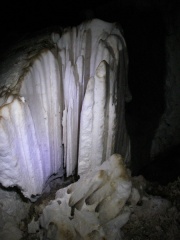Karren (Inventory)/Rillenkarren
From LagWiki
| (One intermediate revision not shown) | |||
| Line 2: | Line 2: | ||
The '''Rillenkarren''' field is used to record stations that exhibit rillenkarren. | The '''Rillenkarren''' field is used to record stations that exhibit rillenkarren. | ||
| - | Rillenkarren are etched flutes or channels which are dissolved by dripping or flowing water. They usually exhibit as parallel | + | Rillenkarren are etched flutes or channels which are dissolved or eroded by dripping or flowing water. They usually exhibit as parallel channels or flutes. The hollows or "rills" may narrow and disappear with distance or, when dissolved by acid rich water like in the Guadalupes, may become deeper with distance. This latter type should probably be called "rinnenkarren" because of this characteristic but for purposes of the ''Carlsbad Cavern National Park Cave Inventory Form'', they are inventoried in this field. |
| - | Rillenkarren may form on soft materials like [[Vertebrate (Inventory)/Bat Guano|guano]] or [[Floor (Inventory)/Sediment/Soil|sediments]]. They can also form in harder materials like bedrock or [[Gypsum (Inventory)/Beds, Massive|massive gypsum]]. The | + | Rillenkarren may form on soft materials like [[Vertebrate (Inventory)/Bat Guano|guano]] or [[Floor (Inventory)/Sediment/Soil|sediments]]. They can also form in harder materials like bedrock or [[Gypsum (Inventory)/Beds, Massive|massive gypsum]]. The defining characteristic is multiple channels separated by ribs of undissolved or uneroded material. The grooves are rounded troughs with sharp ridges. |
==See also== | ==See also== | ||
| Line 11: | Line 11: | ||
==References== | ==References== | ||
*Klimchouk, Alexander B.; Ford, Derek C.; Palmer, Arthur N.; Dreybrodt, Wolfgang (2000) ''Speleogensis; Evolution of Karst Aquifers'' National Speleological Society, Huntsville, AL p 423 ISBN: [[Special:Booksources/1-879961-09-1|1-879961-09-1]] | *Klimchouk, Alexander B.; Ford, Derek C.; Palmer, Arthur N.; Dreybrodt, Wolfgang (2000) ''Speleogensis; Evolution of Karst Aquifers'' National Speleological Society, Huntsville, AL p 423 ISBN: [[Special:Booksources/1-879961-09-1|1-879961-09-1]] | ||
| + | *unknown (1997) ''Geology of Carlsbad Caverns Class - 1997 Memorial Day Expedition'' p 2 | ||
{{Cave inventory}} | {{Cave inventory}} | ||
Current revision as of 05:01, 8 April 2015
The Rillenkarren field is used to record stations that exhibit rillenkarren.
Rillenkarren are etched flutes or channels which are dissolved or eroded by dripping or flowing water. They usually exhibit as parallel channels or flutes. The hollows or "rills" may narrow and disappear with distance or, when dissolved by acid rich water like in the Guadalupes, may become deeper with distance. This latter type should probably be called "rinnenkarren" because of this characteristic but for purposes of the Carlsbad Cavern National Park Cave Inventory Form, they are inventoried in this field.
Rillenkarren may form on soft materials like guano or sediments. They can also form in harder materials like bedrock or massive gypsum. The defining characteristic is multiple channels separated by ribs of undissolved or uneroded material. The grooves are rounded troughs with sharp ridges.
See also
References
- Klimchouk, Alexander B.; Ford, Derek C.; Palmer, Arthur N.; Dreybrodt, Wolfgang (2000) Speleogensis; Evolution of Karst Aquifers National Speleological Society, Huntsville, AL p 423 ISBN: 1-879961-09-1
- unknown (1997) Geology of Carlsbad Caverns Class - 1997 Memorial Day Expedition p 2

